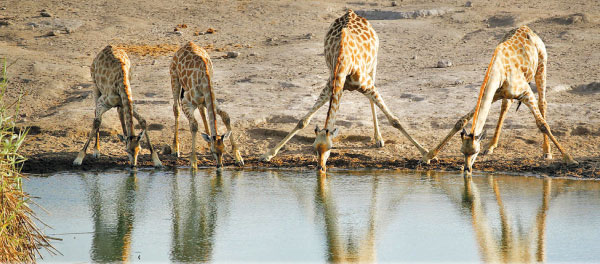The story of the: Giraffe and its long neck
Around 15 million years ago, antelope-like animals were roaming the
dry grasslands of Africa. There was nothing very special about them, but
some of their necks were a bit long.Within about six million years, they
had evolved into animals that looked like modern giraffes, though the
modern species only turned up around one million years ago.
The tallest living land animal, a giraffe stands between 4.5 and five
metres tall - and almost half that height is the neck.Most people assume
that giraffes' long necks evolved to help them feed. If you have a long
neck, runs the argument, you can eat leaves on tall trees that your
rivals can't reach. But there is another possibility.
The prodigious necks may have little to do with food.

The evidence supporting the high-feeding theory is surprisingly
weak.Giraffes in South Africa do spend a lot of time browsing for food
high up in trees, but elsewhere in Africa they don't seem to bother,
even when food is scarce. While the origins of the giraffe's neck is
still a mystery, many scientists think the giraffe backstory is less
about feeding, and more about fighting.
Giraffes are the tallest mammals on Earth, with some males standing
19 feet high. Weighing in at 1,200 to 4,200 lbs., giraffes still manage
to run at up to 35 mph. Besides their long necks, giraffes also have
long, grasping tongues, which can extend 18 inches to reach tasty inner
tree leaves.
The fossil record shows that giraffes evolved from a deer-like
ancestor with a shorter neck. About one million years ago, modern
giraffes had appeared on the African Savannah.
Why did the long neck evolve? Until recently, the most popular theory
involved finding food. Giraffe-like animals who were born with
longer-than-normal necks were thought to have a big feeding advantage,
since in times of scarcity, they could reach higher into trees to forage
for leaves. Longer-necked animals were more successful at surviving, and
passed their long-neck genes onto their offspring.
Over many generations, the modern giraffe evolved. But many
scientists thought this theory was more a "just-so" tale than good
science. And in the 1990s, two scientists in Africa decided to compare
the idea to the realities of giraffe life.
They found that giraffes spent most of the food-scarce dry season
feeding in low bushes rather than in tall trees. In the rainy season,
when leaves were green and plentiful, giraffes were more likely to turn
their attention treeward.
-Internet |


